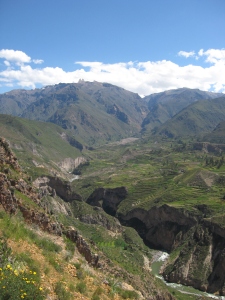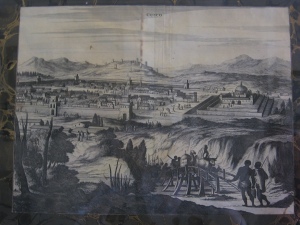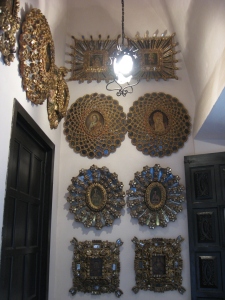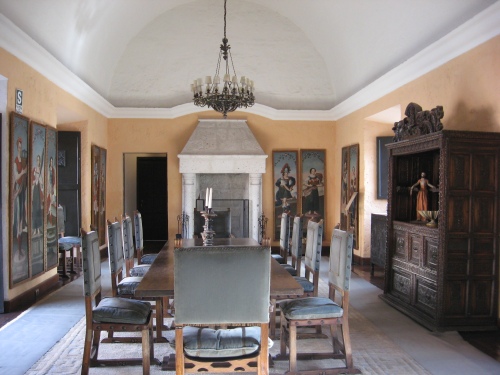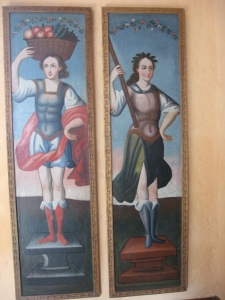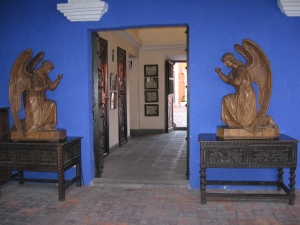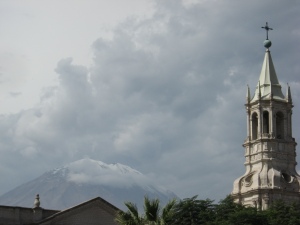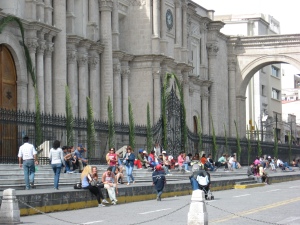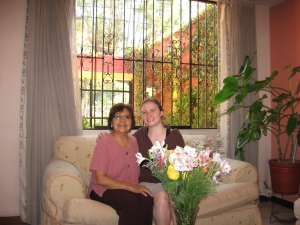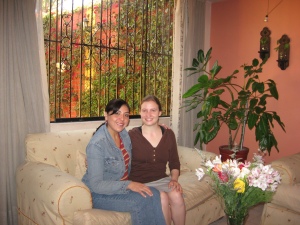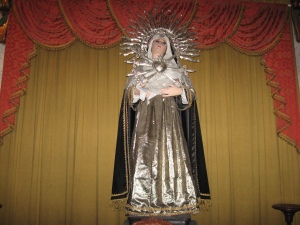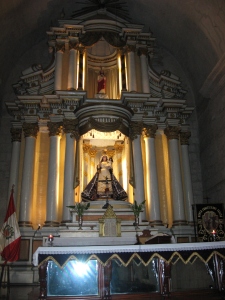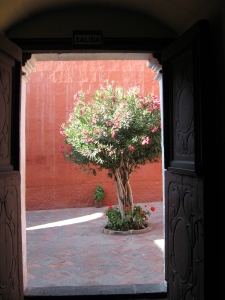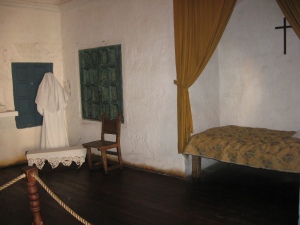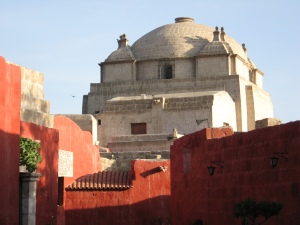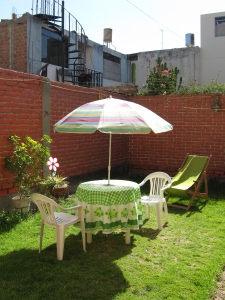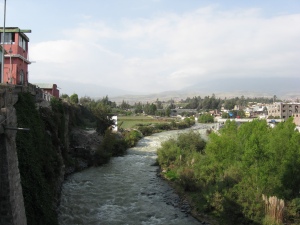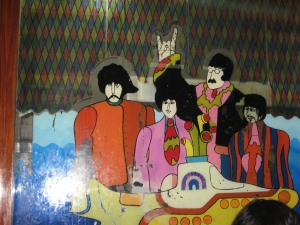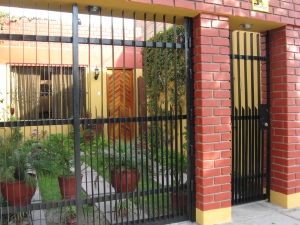The day after Easter I left Arequipa and went on a two-day tour of Colca Canyon. During this trip I learned about the power and weakness of humanity. We can permanently change the world around us, but in the end are still at the mercy of forces greater than ourselves.
I started out my tour by waiting in front of the tour agency. After about 30 minutes, I started to realize that a big part of any tour involves waiting. Because I lived so far from the center of Arequipa, the tour company asked me to wait in front of their offices for the bus to pick me up in the morning. I was supposed to be there at 7:30 with the promise that the bus would pick me up first. I arrived at 7:20 just to be safe, and by 8:00 I was worried that the tour company had forgotten me. When the bus finally pulled around the corner, it was a relief!
We started out by pausing on the outskirts of Arequipa. I had seen the outer edges of the city during my ride from the airport, but was still shocked by the level of poverty. Past a certain point there is no running water, electricity, or garbage collection. Very dirty little children play on or next to piles of trash while stray dogs are search for food in the garbage. It is not a pretty picture and contrasts starkly with the spectacular mountainous scenery that surrounds the city.
We stopped briefly to take photos of the volcanos, to buy cocoa candy at a local store, and to use the bathroom before our long ride. At this bathroom stop I found out that, for some reason or other, the majority of public toilets do not have seats. Fortunately I already knew that there would be no toilet paper!
We then began to drive around the mountains that surround Arequipa. There are checkpoints on the outskirts of the city, I guess to protect the tourists? but our bus ran into a bit of trouble at the first checkpoint. The driver had all the papers, but his name wasn’t on the company list. I am pretty sure the police wanted money (I heard them mention 60 soles) but neither the guide or bus driver were willing to pay up. After about 45 minutes of calling and waiting around, the police finally let us through.
After driving for another hour we made it to the Reserva National where we saw some Peruvian camels. Yes, you read that correctly. The animals we commonly know as lamas or alpacas are in fact a type of camel. There are a total of four different types of camels in Peru. Only the lama and alpaca are domesticated and none of the camels are strong enough to carry humans.
We stopped along the side of the road to look at the wild vicuñas. They are relatively small compared to lamas and alpacas and are now federally protected. It is illegal to domesticate the vicuñas and they are only rounded up once a year and sheared by local people. I got very excited seeing the vicuñas because it was my first time seeing camels outside of a zoo. Little did I know that these animals cover the countryside of Peru.
Our first actual stop was next to this cliff side that had rock formations that look like houses. I can’t remember the exact name in Spanish, but I think it is something like Casa de Piedra (House of Stone). There were also some ladies sitting in a group selling handicrafts. Like with the lamas, I did not realize at the time that people selling ¨genuine¨ baby alpaca scarf, rugs, gloves and hats practically littered the countryside. Indeed, at almost every stopping point along the tour there were people calling out to me (and the rest of the tourists) to buy their items for only 30 soles, 20 soles, 5 soles, amiga! There is always the opportunity to get un discuento! Seriously, I have no idea how much all of the stuff they are selling really costs.
While we were at this little stopping point, our guide Maria-Elena told us to drink some cocoa tea. At that point, I did not believe that cocoa tea did any good, so I decided not to have any. This was the biggest mistake I made during the entire trip.
We continued on driving through the mountains, moving higher and higher above sea level. By the time we reached the highest point of the trip, I was feeling the pressure. We got out of the bus to take some photos and to (yet again) look at the handicrafts. The view was spectacular, but it was difficult to walk without feeling fatigued. All of the tourists who had stopped there in the past made little piles of rocks. We then got back on the bus and began our descent down to the Colca Canyon valley. Here the terraces began.
Very few mountains surround Arequipa and there is actually quite a bit of flat land. This means that the people living in Arequipa city did not need to create terraces. However, in the Colca Canyon area all of the fertile land is located in the mountains. The basic need to grow crops enough to feed an empire led to the well-known Incan terraces. The terraces both drastically change the landscape and are integrated back into it. Because they are natural, they do not seem like something imposed on the land. The Incas built their terraces in locations where they could irrigate water from the mountain to flow directly to their crops. These terraces were so well-built that they are still used today.
By the time we finally descended the winding road down to the valley of Colca Canyon it was about 4:00. I was dropped off at my hotel in the miniscule town of Chivay. After about an hour I met up with my tour group for the final activity of the day which was at the natural hot springs located in the valley. I had never been to hot springs before and was pretty excited. The first thing that greeted me upon entering the hot springs was the smell of rotten eggs (better known as sulfur). We were advised by our guide not to go into the super-heated hut but to try the pool outside. After getting in, I realized that the outside pool was definitely hot enough for me. While in the hot springs I got to know this British girl named Kara. She was on vacation and traveling alone through Peru. For me, one of the advantages of traveling with a tour group is that there is the opportunity to connect with different people. So far, I have been lucky and have made new friends on each and every tour.
As I mentioned earlier, I was waiting a long time for the bus to pick me up at the start of the tour. Well, this continued to be a theme throughout the first day. Everyone was on time except for these four Peruvian people who, I guess, thought that it was OK to be late. After the checkpoint delay, we really had no time to spare and our guide became very frustrated. She lectured the entire bus in Spanish and then, at the end of her speech said that she didn’t need to repeat herself in English! It was seriously one of the funniest moments of the entire trip. Almost everyone on the bus spoke both Spanish and English, so it was no secret that she was lecturing the Peruvians about their tardiness. Her words had the desired effect, and after that they were incredibly punctual.
As part of the tour we went out to dinner at a restaurant that included a traditional folk music and dance show. Up until this point, I was feeling a little odd, but after the second dance number I began to feel seriously ill. I don’t think I have ever experienced a headache that strong before. I knew that it was because of the altitude, but I did not have any of my altitude pills along. For some reason, I was under the impression that after a month in Arequipa I would be just fine. I was so very wrong.
I sat at the table, unable to eat with my headache growing more and more fierce with each drumbeat. I began to feel nauseous and laid my head down on the table. My friend suggested that I leave the restaurant and head back to my room. At that point, I was worried about throwing up at the table. I stumbled out of the restaurant and managed to make it back to my room. Without changing my clothes, washing my face, or brushing my teeth, I fell face first onto the bed.

The guys who were playing for us. For some reason they picked the shortest guy to play the biggest instrument.
At 3am I woke up without a headache and brushed my teeth. I had planned to take a shower, especially after the egg-smelling hot springs, but I could not muster the energy. At 5am I woke up and my headache was just as strong as before. Fortunately, I did not feel like throwing up, but I was not going to push it by eating breakfast. I did, however, drink some cocoa tea. Scarcely ten minutes later I experienced a minor miracle: my headache vanished completely. For the rest of the tour I drank cocoa tea religiously and was not affected by the altitude!
I went out to the town square to wait for the tour bus at 6:00am. While there I took some pictures of the local church and then noticed that something strange was going on. There was this constant stream of people walking back and forth from the central fountain to the local market. At first I could not understand why they were doing this, until I saw that they were carrying buckets. The people who worked in the nearby marked were using the free water from the fountain. The fountain also served as a drinking fountain for the stray dogs who lived in the town. While I don’t know anyone in the US who would use a public fountain for personal use, people here in Peru are much more thrifty. If there is a cheaper way to do something, they will find it.
Our first stop that day was at a little village called Cabanaconde that had a very old church. There were (of course) people selling stuff to tourists. Because we were about to head up to the Cruz del Condor there were a lot of very ugly plastic condor figurines for sale.
The road to Cruz del Condor is not paved, nor is it very wide. In fact, I am sure that when it was built they did not have tour busses in mind. At times, not all four wheels were on the road. Donkeys, lamas, alpacas, sheep, and cows roamed onto the road from the mountainside. Even considering how nerve-wracking the journey was, seeing the condors was worth it!
I remember seeing condors in Brookfield Zoo, but they are incredible in the wild. We were the ones invading their home and they carefully observed all their visitors. The day I was there about 20 condors were flying around. There were a lot of people, but it was very quiet. People were too busy watching and trying to take pictures of the birds to talk. The condors flew a lot closer to people than I would have expected. For me, the combination of the scenery and the animals together was incredibly beautiful. If you ever have the opportunity to visit Arequipa, I strongly recommend traveling to Cruz del Condor.
On the journey back we made several more stops to gaze at terrace-filled landscapes. Every time I see the terraces I am amazed by the control the Incas had over the land and their submission to the natural geography. The Incas did not try to destroy the mountainous terrain of Peru, they improved it.
